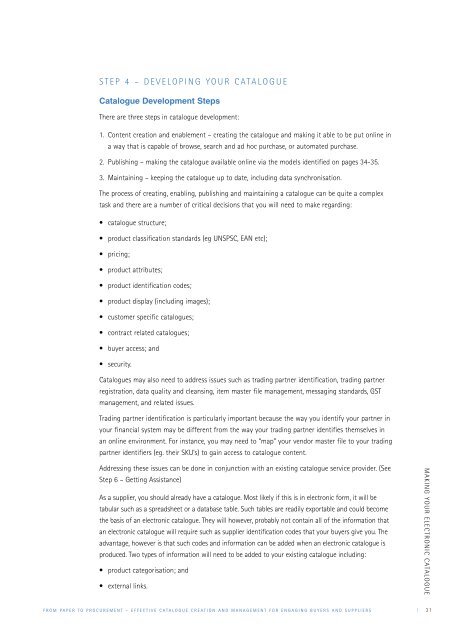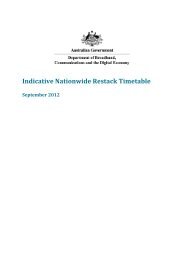From paper to procurement effective catalogue creation and ...
From paper to procurement effective catalogue creation and ...
From paper to procurement effective catalogue creation and ...
You also want an ePaper? Increase the reach of your titles
YUMPU automatically turns print PDFs into web optimized ePapers that Google loves.
S T E P 4 – D E V E L O P I N G YO U R C A T A L O G U E<br />
Catalogue Development Steps<br />
There are three steps in <strong>catalogue</strong> development:<br />
1. Content <strong>creation</strong> <strong>and</strong> enablement – creating the <strong>catalogue</strong> <strong>and</strong> making it able <strong>to</strong> be put online in<br />
a way that is capable of browse, search <strong>and</strong> ad hoc purchase, or au<strong>to</strong>mated purchase.<br />
2. Publishing – making the <strong>catalogue</strong> available online via the models identified on pages 34-35.<br />
3. Maintaining – keeping the <strong>catalogue</strong> up <strong>to</strong> date, including data synchronisation.<br />
The process of creating, enabling, publishing <strong>and</strong> maintaining a <strong>catalogue</strong> can be quite a complex<br />
task <strong>and</strong> there are a number of critical decisions that you will need <strong>to</strong> make regarding:<br />
• <strong>catalogue</strong> structure;<br />
• product classification st<strong>and</strong>ards (eg UNSPSC, EAN etc);<br />
• pricing;<br />
• product attributes;<br />
• product identification codes;<br />
• product display (including images);<br />
• cus<strong>to</strong>mer specific <strong>catalogue</strong>s;<br />
• contract related <strong>catalogue</strong>s;<br />
• buyer access; <strong>and</strong><br />
• security.<br />
Catalogues may also need <strong>to</strong> address issues such as trading partner identification, trading partner<br />
registration, data quality <strong>and</strong> cleansing, item master file management, messaging st<strong>and</strong>ards, GST<br />
management, <strong>and</strong> related issues.<br />
Trading partner identification is particularly important because the way you identify your partner in<br />
your financial system may be different from the way your trading partner identifies themselves in<br />
an online environment. For instance, you may need <strong>to</strong> “map” your vendor master file <strong>to</strong> your trading<br />
partner identifiers (eg. their SKU’s) <strong>to</strong> gain access <strong>to</strong> <strong>catalogue</strong> content.<br />
Addressing these issues can be done in conjunction with an existing <strong>catalogue</strong> service provider. (See<br />
Step 6 – Getting Assistance)<br />
As a supplier, you should already have a <strong>catalogue</strong>. Most likely if this is in electronic form, it will be<br />
tabular such as a spreadsheet or a database table. Such tables are readily exportable <strong>and</strong> could become<br />
the basis of an electronic <strong>catalogue</strong>. They will however, probably not contain all of the information that<br />
an electronic <strong>catalogue</strong> will require such as supplier identification codes that your buyers give you. The<br />
advantage, however is that such codes <strong>and</strong> information can be added when an electronic <strong>catalogue</strong> is<br />
produced. Two types of information will need <strong>to</strong> be added <strong>to</strong> your existing <strong>catalogue</strong> including:<br />
• product categorisation; <strong>and</strong><br />
• external links.<br />
F R O M P A P E R T O P R O C U R E M E N T – E F F E C T I V E C A T A L O G U E C R E A T I O N A N D M A N A G E M E N T F O R E N G A G I N G B U Y E R S A N D S U P P L I E R S | 31<br />
MAKING YOUR ELECTRONIC CATALOGUE







